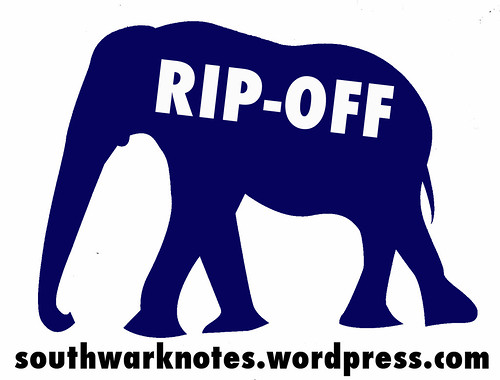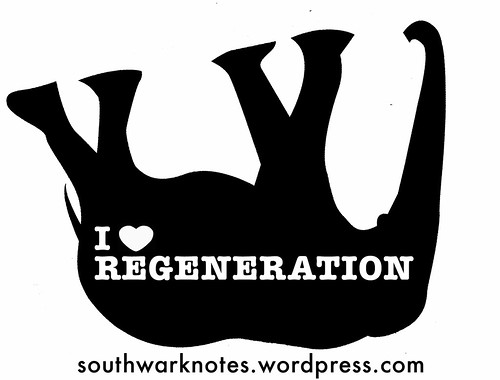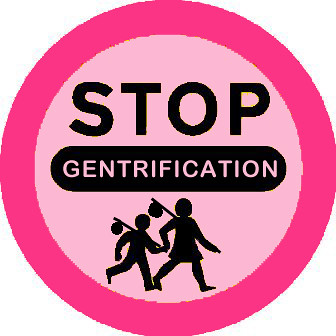A Bureau of the people, by the people, for the people!
In June 2016, the People’s Bureau (Rebecca Davies and Eva Sajovic) organised an open discussion on “ethics, tactics and place-specificity in artistic practice, with particular reference to Elephant and Castle and its labelling as an ‘opportunity area’.” The idea was to critically look at the artistic duo’s work in the Elephant, how they work with communities, the Council and developers. It was an open event and there was a panel of artists and academics contributing. Here we think through some of those questions, who is asking them and who gets to answer them.
Davies and Sajovic have been working as artists in the Elephant and Castle for many years and we have crossed sites and paths many times, offering support sometimes and criticisms at others. Increasingly, we just ended up getting frustrated that their work wasn’t based in any critical position about the regeneration of the Elephant. We wondered why this was the case when so many locals and campaigns were working so hard to counter the spin and lies of the Council and developers.
Their People’s Bureau started as a Tate Modern pilot project in 2014. It later developed when Tate Modern put People’s Bureau in touch with Delancey DV4, a big shot developer who now owns the Elephant and Castle Shopping Centre and who began to sponsor the project. Tate Modern will again be sponsoring a new round of People’s Bureau work as part of its ongoing 2017 Tate Exchange programme.

There is no need to go into detail here about how Delancey operates – have a look at our extensive write up on the planned murder of the Elephant Shopping Centre and 35% Campaign’s post about Delancery’s Tribeca Square development. What you do need to know is that Delancey is a developer accused by HMRC of “aggressive tax avoidance”. Their finances rely on being registered in the Virgin Islands and the use of multiple shell companies. They sealed off without consultation a popular public park (previously Elephant Park and part of the Heygate estate) and are paying a nominal fee of £100 per year to keep it as a construction HQ for Tribeca Square. This space is now declassified as public space. Delancey have sold the land to their own shell company, increasing the price from £8.5m to £18.8m in the course of the transaction. They then used this phony higher land value to demonstrate to Southwark Council that their development is not viable without removing all affordable housing and adding more private residential units.
It is worth mentioning that the artists had already worked with the previous owners of the Shopping Centre, St Modwen, as early as 2010, when their ‘Studio at the Elephant’ project was run from two vacant shops there. St Modwen Properties had partnered with Salhia Real Estate in 2002 to acquire the Shopping Centre for £29.25m in the hope of redeveloping it, but plans were delayed by the slump in the property market caused by the global financial crash of 2008/9. However, it still made a nice profit when it sold it for 80m in 2013 to a partnership of Delancey and Dutch pension fund APG. Delancey are planning on demolishing it to make way for hundreds more private rented homes (with maximum 3 year tenancies), a new LCC campus, a cinema and high street shops. The current shopkeepers are expected to sod off and the Shopping Centre market stallholders “may be able to” pitch up at the few replacement pitches promised at Tribeca Square. Considering that Delancey have already changed their original agreement promising to provide affordable retail space in Tribeca Square to displaced shops by giving this space to Sainsbury’s – we shouldn’t be holding our breath for an open-armed welcome to anyone being booted out of the existing Shopping Centre.
This is all by way of introduction to the kind of real-estate partner the People’s Bureau has chosen to work with in producing public art supported by Tate and Arts Council England. But what about the Tate itself, that big art factory on the Thames? Tate is clear in its strategy to embed art into real-estate development and also clear about carrying on the good work of making North Southwark into a luxury quarter – a plan which goes back to the Docklands developments and which the Council has been putting into place for the past 30 years. This is what they had to say about the Heygate estate ‘regeneration’ masterplan:

Tate makes no mention of any qualms they have about 1100 lost homes and those displaced out of the area – they see the Heygate demolition as an opportunity.
In a somewhat naïve write-up after their June discussion, the People’s Bureau say this about funding: “There is a tension between payment and action. Can we expect to influence and not be influenced ourselves? It is a dirty context, but there are opportunities and possibilities there.” The tension between payment and action plays out between receiving funding and the blessings of Delancey and the People’s Bureau’s ability to speak freely about what is happening in the local area. Sadly, in the work of the People’s Bureau you won’t see much challenging or engaging with Delancey’s ground zero plans for the Shopping Centre, their theft of a public park and plans for making Elephant a luxury destination. For us this is less an argument about taking developer money for projects but more the thorny question of what you actually critically do and say from that money. There is also precious little encouraging locals to involve themselves in the planning process by criticising the plans or making their own plan. In the same text, the People’s Bureau go on to think about the need to negotiate, and they say: “Trying to work in the ‘dirty context’ of a globally affected urban development is complex, but art and artists are not just a ‘clip on’. There needs to be negotiation, on both sides. We need to know what an organisation’s belief system is in order to engage with it.”

Shopping Centre painting by Rebecca Davies
Davis and Sajovic are artists who have a long-term engagement with the area, so how is there any doubt as to what the belief system of Delancey is? Moreover, if the full power of Southwark Council’s legal and planning team has rolled over to Delancey, what chance does the People’s Bureau have in renegotiating or changing Delancey’s plans? What effort has been made to do that? How is it working to redress the imbalance between the community and the developer? What exactly are the opportunities and possibilities in this ‘dirty context‘?
Putting The Cart Before The Elephant: Empowerment for surrender
The goal of the People’s Bureau, as stated by the artists, is “to support the essential preservation into the future” of the Elephant’s “diversity of culture, skills, networks and underlying spirit of the place”. Operating out of a customised traders’ mobile cart first given to them by Delancey, the artists began by organising fun and playful activities, as well as workshops and skills-exchange sessions (‘…sewing, knitting and crocheting, pedicure, massage, facials, gardening, baking, vegetable fermentation, light workshop, embroidery, dreamcatchers making‘, etc). The aim was to collect local E&C knowledge and memories: stories, drawings and photos. All the Bureau’s workshops and artefacts have been thoroughly documented, published or recorded.

At the same time, the artists are maintaining an ongoing open call for archiving artworks that have taken place in Elephant and Castle shopping centre, which the People’s Bureau identified as the “cultural capital” of the area. They invite us to imagine the grand finale of the project as a kind of museum of local culture on the post-demolition site in Delancey’s brand new shopping mall, equipped with Elephant and Castle memories, artefacts and archives: ‘The ambition is that the cart will eventually return to the newly built Elephant & Castle shopping centre, thus creating the link connecting the old and the new Elephant and becoming a museum of local culture’.
Such an ambition seems painfully wistful. Delancey seeks to create a cluster of luxury flats with upscale shops. They will have no ambition themselves to remind the new residents of who and what came before them. There will be no museum, just the dustbin of history for locals.


Most of the Bureau’s activities promise to have empowering effects: employment advice, C.V surgeries and sessions on managing your personal budget, clothes mending, house decoration, carpentry and other skills-exchanges. However, these skills-exchanges (despite the fact that skills are attempting to be exchanged in the artistic encounter between locals and that fun and enjoyment is produced) do not empower people to step outside of the frame they have been put in. That frame is the frame of everyday activities as defined by the artists. The everyday concerns of where the shopkeepers and traders will go, where will local people be able to hang out affordably, what can be done to alter the oncoming tsunami of regeneration etc. – all of these are strangely brushed aside. The empowerment of these skills-exchanges is therefore an empowerment to surrender, to go on with their lives as if nothing was happening in their community.
Locally-sourced locals: the applied art of consultation
We have already written loads about how ‘consultation’ works in the context of a ‘regeneration’ scheme (in particular, see our useful Listening to No End case study of how consultation was spun at Heygate Estate). However, with the People’s Bureau another aspect of consultation opens up, that of artists placed as a conduit for talking to ‘stakeholders‘ in the community. The work of the People’s Bureau works to prepare the displacement of a community by documenting the last breath of community life and carefully archiving its history in this our ‘opportunity area‘. The community is engaged in a process which is never explicitly called consultation, but the artwork and artistic outcomes end up being used by the developer to demonstrate community consent for regeneration.
Art consultation is not unique to the Elephant. All over the country, artists are seen as skillful creative communicators who get invited by councils and/or developers to organise events which are often not presented as consultation, but end up by being used as consultation by the developers seeking local legitimacy. We should stress that this is not consultation that obliges the developer (legally or morally) to make any changes to their plans. It is consultation as a PR job and it is often done by PR companies alongside artists who do this sort of work for much less money and who are seen as less compromised than the suited squaddies of the PR industry. But the Bureau’s activities are not presented as consultation, there is something else at play here.
The work of the People’s Bureau, as artists embedded in regeneration, takes the form of exchanging skills and harvesting personal experiences which are then meticulously made into museum exhibits as traces of a disappearing life. This fine touch of museumisation serves as a heavy-handed procedure of removing life from its natural heavily social context and representing it as an outdated or decaying community whose days are numbered by the logical ‘progress’ of regeneration. Art promises to ‘dignify‘ this life through placing it into (self-made) archives, art books, further work in galleries and modern art museums. Artists usually organise their activities encouraging local communities to share their stories, experiences and memories, turning ‘opportunity areas’ into archaeological excavation sites. It is no surprise that one of Eva and Rebecca’s other Arts Council funded (£13,500) projects is called ‘Unearthing Elephant‘. In their artistic statement, they claim: “we want to ensure that the shopping centre and its communities are documented and made visible at this time of dramatic change”. This process of museumisation turns the local community into objects to be researched through the expert lens of the artist-archivist. Collected artefacts (personal stories or objects fashioned by the locals) are carefully documented and archived for future institutional treatment that will potentially bring new value to a post-regeneration site. All of this is set in an arena apart from consultation or the planning process.
The role of the community in this mummification process despite being promoted as an ‘active‘ one that contains ‘power‘ is only really about ‘visibility‘ where there’s neither a publicly constructed space for confronting the ‘dramatic change’ nor for questioning who really has power in this ‘contested‘ site and how to make a local counter-power. There will always be a fundamental power imbalance here: the community is studied in its natural habitat by the artists sponsored by the council/developers. The unspoken agreement is that the artists never really look at how the community’s desires might be in conflict with regeneration plans. Without tackling that power imbalance, all of this works to prove that regeneration is inevitable: it is the best of all possible worlds, there is no alternative. The community is destroyed and its colourful life is placed in “the museum of fish and chips”.
How different the reality is from what Eva Sajovic’s says in her research profile: “In particular I am looking at participation as a method for engaging people in taking hold of their agency, political co- and self-determination and democracy. This includes looking at ways to use art as a tool to support people in being resilient and active agents of their lives, as a catalyst in the processes of power, decision-making and the erosion of public space.” Nowhere in ‘Unearthing Elephant’ or other of the Bureau’s projects is this foregrounded. There is no public trace of engagement with decision-making or the building of counter-power to the developer’s and council’s social cleansing machine.
At the same time the artifacts and events of the People’s Bureau end up being presented as consultation. Here is the pink cart being displayed by Delancey at their community consultation event:


People’s Bureau art displayed in Delancey’s consultation, August 2015
So, there is a double game being played here: the artists claim to be engaged in a process of making the community visible, while the developer uses this process to demonstrate that the community is visibly engaged with the process of regeneration. Are the people working with the People’s Bureau ever told that their activities are forming part of a pretend conversation with the developer? In our minds, this is not giving people agency and power. Power is not magically produced from the sheer ‘visibility’ and choreographed voices of a community about to be displaced. Such an archiving of voices does not amplify anything other than the actual muting of those voices in the celebration of an impotent nostalgia in the present tense.
Those star-crossed lovers: art and activism
Despite talking of art building up resilience and power, artists like the People’s Bureau tend to see their activities as distinct from activism (or anything which may rock the boat): “Art and activism, they are not the same thing, and one cannot replace the other. However they might exist alongside each other, finding moments of connection and ways to strengthen and enrich each other. In addition, artists may be able to get access to people and places which activists could not.” The Bureau asks where we should draw the borderline between art and activism? But they don’t ask if this separation is possible only in an era of making art subservient to developer’s interests. Should artists limit themselves to energising what they see as community, neighbourliness and sociability? Or it is just not enough? Does art involve the freedom to speak out about the plans for the Shopping Centre? Does it involve informing people of the future to come? Or is it in fact merely consigning the present to the museum of the past? If it is at all true artists can get access to places local people cannot then surely they are then in a very privileged place to speak out? Maybe access is premised only on not speaking out. While these questions remain unanswered, the Bureau’s pink mobile cart has traveled, after hard archaeological work in the shopping centre, to be proudly displayed by Delancey in their consultation sessions. So, while the Bureau’s activities are claimed not to be activism, they become an integral part of a ‘consultation’ which is justifying community support for whatever Delancey’s money cares to say goes. The cart stands to show the colourful local community is not against any of Delancey’s plans to purge them from the area and to prove a point to critics (and activists) claiming that regeneration is erasing the history of the place. Delancey has spoken of how they sponsor cultural projects wherever their assets are. Much like the asset of the high value land the Shopping Centre sits on, sponsored artists are appreciated as low value assets to make regeneration flow without much conflict or anything seeming out of the ordinary.
Public artists like the People’s Bureau like to present themselves as part of the solution, but to be able to challenge the lies and violence of regeneration, it is useful to understand their work as part of the problem. The Bureau claim not to be activists, but in fact they work as activists for Delancey’s interests, by achieving Delancey’s desired results and acting as Delancey’s on-the-cheap service provider. It works to extend Delancey’s ‘social license to operate’ by giving them a human face they don’t have. It works to offer skills which will not challenge or shape the regeneration in any way. It works as one way to neutralise criticism of the regeneration. It works indirectly as a public relations exercise masquerading as community activities. It pretends to be of the people, by the people and for the people. Whilst pretending to ‘empower’ local people as citizens so far it seems to only work to reduce them to colourful tribes ready for surrender.



























